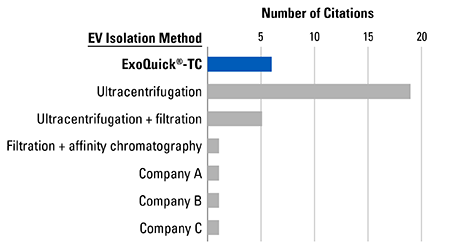REVIEW HIGHLIGHT: Therapeutic Prospects of Extracellular Vesicles in Cancer Treatment
With the growing recognition that extracellular vesicles (EVs) are involved in modulating the tumor microenvironment, a number of labs are not only studying how EVs are involved in cancer biology but harnessing EVs for cancer treatments. A July, 2018, review delivers an excellent overview of the different strategies researchers are taking:
Therapeutic Prospects of Extracellular Vesicles in Cancer Treatment
Chulpanova, DS, et al. Front Immunol. 2018 July 3; 9: 1534. PMCID: PMC6037714
What makes this review great:
Chulpanova, et al, discuss thirty-four different studies, organizing them by EV source—tumor-derived EVs, immune cell-derived EVs, and mesenchymal stem cell (MSC)-derived EVs—and whether the EV carries a cargo of anti-tumor small molecules, specific antigens, or small RNAs. Their summary table is an excellent and well-referenced resource for those interested in learning about all the different approaches.
Quote to Note:
“From priming the immune response to delivering ncRNAs and antitumor drugs, EVs provide a unique biological means of targeting tumors and their microenvironments, minimizing cytotoxic effects, and increasing the efficacy of treatments at lower drug doses…[although] progressing their use as therapeutic tools requires full characterization of such disadvantages and limitations before the promise of MVs in clinical practice is achieved.”
How SBI helped:
In their summary table, Chulpanova, et al., include the EV source cells for each study, as well as the purification method. Out of the thirty-four citations presented in the table, ExoQuick-TC was the most widely used commercial EV isolation method (used in six citations, Figure 1).

Figure 1. ExoQuick-TC was the most widely-used commercial EV isolation method referenced in the Chulpanova, et al., review.
ExoQuick products are excellent alternatives to ultracentrifugation when it comes to isolating EVs—they are quick, provide clean, high-yield EV preps, and are compatible with small sample volumes and high-throughput workflows. See the data comparing ExoQuick ULTRA with ultracentrifugation here.
Other ways SBI can help:
While ExoQuick-TC is the most-used EV isolation reagent mentioned in the Chulpanova, et al., review, SBI has other products and services that support a complete EV workflow, from isolation and characterization to EV transfection and EV engineering. Take a look at all the different ways SBI can accelerate your EV research—see our Exosome Research Products and Exosome Services.


